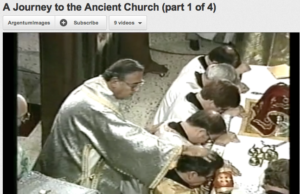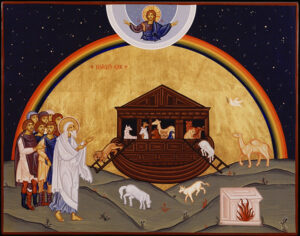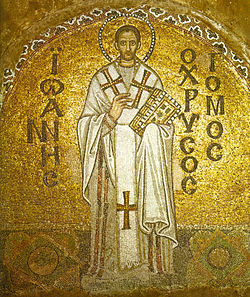On 16 May 2013, The Calvinist International posted an article by Pastor Steven Wedgeworth: “Alexander Schmemann on Ecclesiastical Counter-Utopia.” It is a curious article; apart from the one opening sentence by Pastor Wedgeworth, the rest of the blog posting consists of selections from a speech given by Fr. Alexander Schmemann in 1981 titled: “Between Utopia and Escape.” I could be mistaken but it seems that the point Pastor Wedgeworth wants to convey via Father Schmemann is the warning that some people convert to Orthodoxy out a desire to “escape from the system” and “become weird.” (As if the Reformed tradition doesn’t have its own representative “weirdos”! 🙂 )
Fr. Schmemann recounts,
And again, I am very well placed to know that, because, unfortunately, my religion, Eastern Orthodoxy, is very often identified as a provider of those kind of little mystical techniques which will satisfy the dropout’s heart for personal bliss out of The System. (Emphasis added.)
Today, at Penn Station, a man whom I knew many years ago, approached me and said, “Hello, Father Schmemann.” And I said, “Who are you?” because he was dressed in a kind of black robe and was nearly stepping on his beard. Everything about him was peculiar, from his hair, to his strange hat… He was probably playing a monk from Mt. Athos or something of that nature, but I knew he was born in Brooklyn. I know many converts to Orthodoxy who think that when they become Orthodox, they have to also become Russian monarchists, and think that the restoration of the Romanovs in Russia is the only condition for the world’s salvation. (Emphasis added.)
Pastor Wedgeworth is attempting a bit of apologetics jiujutsu, utilizing the opponent’s force against him. Father Schmemann enjoys the unusual status of being one of the Orthodox writers influential among Reformed Christians who want to deepen their spiritual roots by exploring the Liturgy and the early Church. “Unfortunately,” Father Schmemann’s writings have often become the “gateway drug”—something much denied by his Protestant followers–leading Protestants to convert to Orthodoxy. Apparently, Pastor Wedgeworth is attempting to stem the flow of converts by invoking the “great” Alexander Schmemann who warned against converting to Orthodoxy: “It’s escapist. People who convert do so for shallow, immature reasons.” The hidden subtext here seems to be: “You don’t have to go all the way and become weird. You can take the more mature route of staying Protestant.” That is, being ½ Orthodox and ½ Protestant. Or is it being ¼ Orthodox, ¼ Anglican, ¼ Roman Catholic, and ¼ Reformed? 😉
It’s Not 1981 Anymore!
When Father Schmemann gave the talk “Between Utopia and Escape” in 1981, the United States of America was a very different country. Ronald Reagan had just begun his presidency. Back then, Protestantism was thriving and growing. One could say that the 1970s and 1980s were the springtime of Evangelicalism. Back then, Orthodoxy consisted mostly of small ethnic enclaves. People drawn to Orthodoxy back then were often discouraged on the grounds that converting to Orthodoxy also entailed assuming the ethnic identity of that parish.
But in 1987 something happened that changed Orthodoxy in America. Some two thousand former Evangelicals were welcomed into the Orthodox Church. This bold action was taken by Metropolitan Philip, the Primate of the Antiochian Orthodox Church in America, with the approval of Patriarch Ignatius IV. The people they welcomed were not fringe weirdos, but had roots in the Evangelical mainstream. Many had been part of the leadership of the huge parachurch organization, Campus Crusade for Christ. Many had studied at Evangelical institutions like Wheaton College, Moody Bible Institute, Dallas Theological Seminary etc. Their journey to Orthodoxy has been described by the late Father Peter Gillquist in Becoming Orthodox. See also Peter Gillquist’s Coming Home: Why Protestant Clergy are Becoming Orthodox.
The reception of the Evangelical Orthodox brought about a change in thinking. Many began to think that it was possible for one to convert to Orthodoxy without undergoing a change in ethnicity. This change in thinking was facilitated by the Antiochian archdiocese’s commitment to evangelism and church planting. This desire to reach out to the American mainstream was also shared by the Orthodox Church in America (the jurisdiction that Father Schmemann was part of). Far from discouraging them, Father Schmemann encouraged them in their journey to Orthodoxy. Peter Gillquist credits him with their becoming Orthodox (pp. 130-131). This effectively refutes the point Pastor Wedgeworth tried to make in citing Father Schmemann.
Is Fleeing the Titanic Escapist?
Protestantism and Evangelicalism also underwent considerable changes since Alexander Schmemann issued his warning in 1981. The 1980s was the peak of the evangelical renewal movements among the mainline denominations. However, they were largely unsuccessful in reversing the trend towards avant garde doctrines and deviant sexual practices. In addition, Protestant ecclesiology was turned on its head with the emergence of the mega churches, and Protestant worship became nearly unrecognizable under the onslaught of contemporary worship. Conservative seminaries became fierce battlegrounds with disputes over evolution, inerrancy, the New Perspectives on Paul, critical hermeneutics, and patristics intruding on longstanding denominational distinctives that demarcated the interior boundaries of Evangelicalism. Among these various movements there emerged the neo-Reformed movement which sought to reintroduce the rigor of the Reformed faith and Puritanism to popular Evangelicalism. One of the irony of the neo-Reformed movement is that the Puritans who came to the New World were “weirdos” (Nonconformists) and “escapists” (who fled after failing to reform England). Father Schmemann’s criticism cuts in both directions so one should beware of quoting him freely.
In many respects the growing stream of converts to Orthodoxy point to the interior collapse of Evangelicalism and Protestantism. These are folks deeply committed to Jesus Christ as their Lord and Savior. They are deeply distressed by the growing doctrinal disarray within Protestantism and are drawn to the historic faith of Orthodoxy. They are also drawn to the stability and dignity of liturgical worship. Many have been hesitant to convert to Orthodoxy because they know that it entails a break with their Protestant past and could cause pain for their loved ones. It would be unfair to folks like these to insinuate that they want to “become weird” or that psychological factors prompted their conversion to Orthodoxy.
For many it was their devotion to the Bible as God’s inspired word that led them out of Protestantism into Orthodoxy. In their study of Scripture many have had to wrestle with the Apostle Paul’s letter to the Thessalonians which seems to teach not sola scriptura, but Holy Tradition:
So then brothers, stand firm and hold to the traditions we passed on to you, whether by word of mouth or by letter. (II Thessalonians 2:15).
Here Paul does not assign a superior status to his writings—which is what one would expect if Paul held to sola scriptura—but views oral and written tradition as having equal authority. Furthermore, Paul’s teachings in II Timothy lend credence to apostolic succession.
What you heard from me, keep as the pattern of sound teaching, with faith and love in Christ Jesus. Guard the good deposit that was entrusted to you—guard it with the help of the Holy Spirit who lives in us. (II Timothy 1:13-14)
The phrase “what you heard” is a reference to oral tradition. When he wrote II Timothy towards the end of his life, the Apostle Paul could have instructed Timothy to collect and compile all his writings. This would support the Protestant principle of sola scriptura, but instead we find Paul instructing Timothy to commit to memory the oral tradition and to pass on this tradition to others. This traditioning process opens the door to the early Church. Evangelicals who then studied the early church found themselves face to face with an early Christianity committed to the Apostles’ teachings and to Orthodoxy which has kept the Apostolic Tradition for the past two millennia.
My journey to Orthodoxy was a lot like fleeing the Titanic. Having been a member of the mainline United Church of Christ (UCC) which has roots going back to Puritan New England I was in a good position to see the boat listing and taking on water. The UCC had the reputation for being on the cutting edge of liberal theology. As a church history major at Gordon-Conwell Theological Seminary I was able to study historical theology. My research led me to conclude that much of Protestantism’s woes can be traced to the doctrine of sola scriptura. I was fortunate to have learned about Orthodoxy and met former Evangelicals like Peter Gillquist. Knowing that one could convert to Orthodoxy without relinquishing one’s cultural identity made it much easier for me. As I stood on the railing of the sinking “Titanic,” I saw myself faced with the two options: (1) the two thousand years old Ark of Salvation (Orthodoxy) or (2) the myriad of small lifeboats from the “Titanic” (the splinter denominations). I chose The Orthodox Ark. It had been around for the past 2,000 years. The antiquity and stability of the Ark of Orthodoxy stands in sharp contrast to the many tiny Protestant life boats made from bits and pieces of the sinking “Titanic.”
Many who convert to Orthodoxy do so out of the conviction that what the Orthodox Church teaches is consistent with Scripture and with the teachings of the early church fathers. Peoples’ move to Orthodoxy has also been facilitated by the experience of the holy in the Liturgy. Orthodoxy in America is going through a period of transition. It is moving out of its ethnic ghettoes into the mainstream of American society. All English liturgies are becoming more common. As more and more Protestants and even Roman Catholics enter into Orthodoxy, it is going to be harder to use being weird or escapist as reasons for converting to Orthodoxy.
Robert Arakaki










Recent Comments